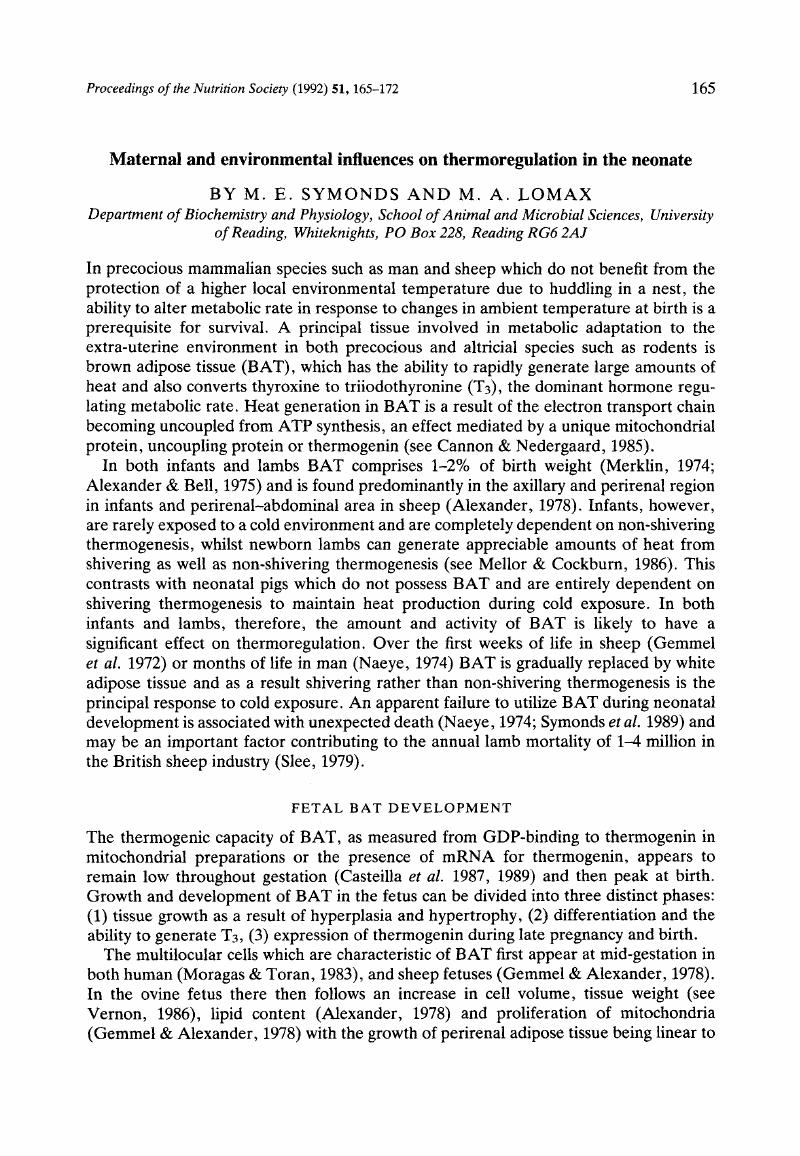Crossref Citations
This article has been cited by the following publications. This list is generated based on data provided by Crossref.
1993.
Abstracts of Communications.
Proceedings of the Nutrition Society,
Vol. 52,
Issue. 3,
p.
272A.
1994.
Abstracts of Communications.
Proceedings of the Nutrition Society,
Vol. 53,
Issue. 3,
p.
158A.
Symonds, M. E.
Bird, J. A.
Clarke, L.
Darby, C. J.
Gate, J. J.
and
Lomax, M. A.
1994.
Temperature Regulation.
p.
309.
Laburn, Helen
Mitchell, Duncan
and
Goelst, Kathleen
1994.
Temperature Regulation.
p.
229.
Carstens, Gordon E.
1994.
Cold Thermoregulation in the Newborn Calf.
Veterinary Clinics of North America: Food Animal Practice,
Vol. 10,
Issue. 1,
p.
69.
1995.
Abstracts of Communications.
Proceedings of the Nutrition Society,
Vol. 54,
Issue. 1,
p.
1A.
Fiorotto, Marta L
Davis, Teresa A.
Schoknecht, Patricia
Mersmann, Harry J.
and
Pond, Wilson G.
1995.
Both Maternal Over‐ and Undernutrition During Gestation Increase the Adiposity of Young Adult Progeny in Rats.
Obesity Research,
Vol. 3,
Issue. 2,
p.
131.
Eastwood, Martin
1997.
Principles of Human Nutrition.
p.
309.
Oya, Atsuko
Asakura, Hirobumi
Koshino, Tatsuo
and
Araki, Tsutomu
1997.
Thermographic demonstration of nonshivering thermogenesis in human newborns after birth: its relation to umbilical gases.
jpme,
Vol. 25,
Issue. 5,
p.
447.
Sauer, Pieter J. J.
1998.
Principles of Perinatal—Neonatal Metabolism.
p.
1027.
Unno, Nobuya
Kuwabara, Yoshinori
Okai, Takashi
Kozuma, Shiro
Nakayama, Masahiro
Takechi, Kimihiro
Masuda, Haruo
Ogami, Yoshiko
Tsushima, Ruriko
Ryo, Eiji
Sakai, Masato
Kido, Koichiro
Kikuchi, Akihiko
and
Taketani, Yuji
1998.
Metabolic and Endocrine Responses to Cold Exposure in Chronically Incubated Extrauterine Goat Fetuses.
Pediatric Research,
Vol. 43,
Issue. 4,
p.
452.
Kuzawa, Christopher W.
1998.
Adipose tissue in human infancy and childhood: An evolutionary perspective.
American Journal of Physical Anthropology,
Vol. 107,
Issue. S27,
p.
177.
BUDGE, HELEN
DANDREA, JENNIFER
MOSTYN, ALISON
EVENS, YVONNE
WATKINS, RYAN
SULLIVAN, CLAIRE
INGLETON, PATRICIA
STEPHENSON, TERENCE
and
SYMONDS, MICHAEL E.
2003.
Differential Effects of Fetal Number and Maternal Nutrition in Late Gestation on Prolactin Receptor Abundance and Adipose Tissue Development in the Neonatal Lamb.
Pediatric Research,
Vol. 53,
Issue. 2,
p.
302.
BUDGE, HELEN
DANDREA, JENNIFER
MOSTYN, ALISON
EVENS, YVONNE
WATKINS, RYAN
SULLIVAN, CLAIRE
INGLETON, PATRICIA
STEPHENSON, TERENCE
and
SYMONDS, MICHAEL E.
2003.
Differential Effects of Fetal Number and Maternal Nutrition in Late Gestation on Prolactin Receptor Abundance and Adipose Tissue Development in the Neonatal Lamb.
Pediatric Research,
Vol. 53,
Issue. 2,
p.
302.
Symonds, Michael E.
Pearce, Sarah
Bispham, Jayson
Gardner, David S.
and
Stephenson, Terence
2004.
Timing of nutrient restriction and programming of fetal adipose tissue development.
Proceedings of the Nutrition Society,
Vol. 63,
Issue. 3,
p.
397.
Shen, Weihua
Wisniowski, Paul
Denne, Scott C.
Boyle, David W.
and
Liechty, Edward A.
2005.
Anabolic effects of insulin and IGF-I in the ovine fetus are reduced by prolonged maternal fasting.
American Journal of Physiology-Endocrinology and Metabolism,
Vol. 288,
Issue. 5,
p.
E907.
Hyatt, M A
Butt, E A
Budge, H
Stephenson, T
and
Symonds, M E
2008.
Effects of maternal cold exposure and nutrient restriction on the ghrelin receptor, the GH–IGF axis, and metabolic regulation in the postnatal ovine liver.
REPRODUCTION,
Vol. 135,
Issue. 5,
p.
723.
Derosas, Renzo
2009.
The joint effect of maternal malnutrition and cold weather on neonatal mortality in nineteenth-century Venice: An assessment of the hypothermia hypothesis.
Population Studies,
Vol. 63,
Issue. 3,
p.
233.
Nishizuka, Makoto
Kishimoto, Keishi
Kato, Ayumi
Ikawa, Masahito
Okabe, Masaru
Sato, Ryuichiro
Niida, Hiroyuki
Nakanishi, Makoto
Osada, Shigehiro
and
Imagawa, Masayoshi
2009.
Disruption of the novel gene fad104 causes rapid postnatal death and attenuation of cell proliferation, adhesion, spreading and migration.
Experimental Cell Research,
Vol. 315,
Issue. 5,
p.
809.
Budge, H.
Sebert, S.
Sharkey, D.
and
Symonds, M. E.
2009.
Session on ‘Obesity’ Adipose tissue development, nutrition in early life and its impact on later obesity.
Proceedings of the Nutrition Society,
Vol. 68,
Issue. 3,
p.
321.



